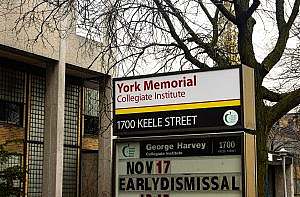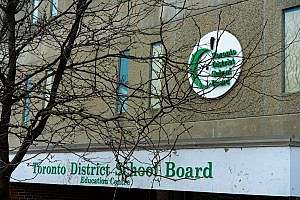Teachers not the cause of York Memorial’s troubles
If there is one thing that teachers, students, administration, and the media all agree on, it’s that the forced merger of York Memorial CI and George Harvey CI, two high schools located at Keele and Eglinton, has been an unmitigated disaster. Overcrowding, inadequate facilities, a revolving door of administrators, and escalating levels of chaos and violence culminated this fall in a legal refusal of unsafe work by 14 staff, a full-scale student walkout, a heavy-handed police presence in the school, and a Ministry of Labour investigation that found the Board wanting in assessing the risk of workplace violence.
As a result of the attention that the school’s troubles have received in the media over the past month, two competing narratives have emerged. One narrative – call it the Toronto Sun narrative — paints a picture of a school overrun by gangs, drug dealers, “fight clubs,” and riots. The other – we’ll call this the student walkout narrative, though it’s a narrative largely being shaped by local community groups – blames “racist teachers” for abandoning their students, calling the police instead of “de-escalating,” and reinforcing racist stereotypes of them in interviews with the press.
Both of these narratives seize on details of what has been transpiring at York Memorial, but neither is accurate. The problems at York Memorial were not caused by students or teachers. They are the result of systemic failure resulting from underfunding, neoliberal management, and layers of bad-decision-making that were made by elected trustees and senior staff alike.
 The problems go back to 2019, when York Memorial was destroyed by a terrible fire. Students and staff were temporarily relocated inside George Harvey, but it was an uncomfortable arrangement that no one wanted to remain permanent, so the following year they were moved again, this time to the vacant site of the former Scarlett Heights Entrepreneurial Academy while their school got rebuilt. Instead of waiting for that process to be completed however, the Board saw a cost savings in moving them back to George Harvey. Though the superintendent, Kwame Lennon, has framed the decision as bringing York Memorial “back to the community,” it was really just simple economics: why pay to maintain three schools when you can pay to maintain two? A poll taken before the merger had 93 percent of students from York Memorial and 53 percent of students from George Harvey opposing the idea. Didn’t matter. The decision was made anyway. So much for “student voice.”
The problems go back to 2019, when York Memorial was destroyed by a terrible fire. Students and staff were temporarily relocated inside George Harvey, but it was an uncomfortable arrangement that no one wanted to remain permanent, so the following year they were moved again, this time to the vacant site of the former Scarlett Heights Entrepreneurial Academy while their school got rebuilt. Instead of waiting for that process to be completed however, the Board saw a cost savings in moving them back to George Harvey. Though the superintendent, Kwame Lennon, has framed the decision as bringing York Memorial “back to the community,” it was really just simple economics: why pay to maintain three schools when you can pay to maintain two? A poll taken before the merger had 93 percent of students from York Memorial and 53 percent of students from George Harvey opposing the idea. Didn’t matter. The decision was made anyway. So much for “student voice.”
What has been so additionally maddening about the chaos of the merger is that both students and teachers saw it coming and pleaded for adequate resources to be provided to get the school ready and for a plan to be put in place to facilitate the community-building that would need to happen if the two schools were going to become one. In a letter sent to the school communities on July 8, 2021, the superintendent promised that the merger would see the provision of additional administrative and support staff, time and resources to allow for team-building activities for both staff and students, and “necessary capital improvements” to the George Harvey building. None of these things happened.
A veteran principal was given a year to prepare for the merger. No one at the school is clear what he did during that year or what challenges he might have encountered in upgrading the facilities in time, but when the newly “consolidated” York Memorial opened in September, it was nowhere close to being ready for the arrival of 1400 students. There were classrooms without doors, doors without locks, and teachers without keys. The gymnasium was stacked with furniture and unusable. The auditorium was under repair and therefore assemblies could not happen. Promised events that would introduce the two staffs to each other prior to opening never happened. Hallways were jam-packed and overcrowded. Half the students didn’t know half the other students or half the teachers. Half the teachers didn’t know the building or each other. Worse, an entirely new admin team was installed with no history with either student population.
Staff began raising concerns from the first day – verbally at first, then in writing through Health and Safety Concern Forms, which soon were being handed in daily. Kids were patient at first, but soon, teenagers being teenagers, some began to act out. Fights broke out with increasing frequency. The principal tried to suspend several students who had been causing trouble, but he was blocked by his superiors and told his staff he was asked, “Why are you suspending Black students?” The overturning of those suspensions helped cement the perception that the administration lacked the ability to enforce rules – not that any had been communicated since the auditorium was still shuttered and no assemblies were possible – and the breakdown of authority led, predictably, to mayhem. Teenagers will push boundaries, and at York Memorial, there were none.
Unfortunately, a purportedly well-meaning attempt to protect the school’s Black and racialized students from racism subjected them instead to neglect, which is equally racist. While it might otherwise be commendable that the Board was trying to address its racist history of disproportionately disciplining and suspending Black youth, York Memorial is a school that consists almost entirely of racialized and Black students, so it was natural that when kids would misbehave, as they do in all schools, those students would be reflective of the school population. In other words, there was no one else to suspend.
It also left 1300 students, who were just trying to live their lives and go to school, at the mercy of a few dozen bullies, who were taking over washrooms and terrorizing the school.
As incidents grew more frequent and more violent, the administration was increasingly revealed to be helpless to do anything about it. Students pleaded with their teachers to do something, but the teachers, whose voices were ignored at every turn, were helpless. Some began going on medical leave. So did the principal, who was replaced by an acting retired principal.
Speculation that many of the problems stemmed from rivalry between gangs of the former schools has been largely refuted by both students and staff. Most of the ruckus was being caused by a small group of students from both former schools. The overwhelming majority of the students were just trying to come to school, get good grades, and hang out with their friends. Normal teenage stuff. These students, themselves also Black and racialized, were made to feel devalued by a system that dumped them in a run-down facility that was in no shape to house them and that proved increasingly incapable of protecting them from bullying and harassment. Students, particularly girls, complained of feeling unsafe in the washrooms and ran to nearby businesses to use their facilities.
By this time, intruders in the school were roaming the hallways freely. Young men wearing balaclavas with sunglasses and zip up “shark-hoodies” that hide the face – maybe students, maybe intruders, no one knew – hung around outside washrooms and, with increasing frequency, began barging into and even taking over classrooms while teachers were teaching. At least three drug overdoses were reported to have happened on school property. According to a few teachers I spoke to, one girl was taken to the hospital after ingesting drug-laced gummy bears.
Staff pleaded for the Board to take the problems at the school seriously. Some called for the Board to move the school online until the facilities and procedures were ready to return everyone in person.
On October 21, after a student was caught with a large quantity of drugs, several dozen students swarmed the main office shouting death threats at one of the vice-principals. This was captured on videos made by other students. The glass of one of the school’s main doors was kicked in. Another vice-principal was also issued death threats. (She went on medical leave the following week and never came back). On October 28, a larger riot broke out involving over a hundred students that saw multiple fights break out in various parts of the building. No lockdown was called – no lockdown procedure or drills at that time had yet been put in place, and many teachers didn’t even have keys to lock their doors – but several staff proceeded to take their own initiative by locking down their own classrooms. One teacher recounted how students were pounding on her door, at first begging, then shouting angrily, for her to “do something” and call 911, which, in tears, she was attempting to do from her cell phone while pleading with the students that she was trying her best. Another teacher recounts how one of her students, seeing her alone in the classroom, urged her to leave the building immediately, then on her way nervously out of class, she checked the lock on her door and said, “Miss, I’m just going to close this door for you.” The teacher told me that this sent chills down her spine.
 Fourteen teachers went on legal work refusals the following week. Most of them were wracked with guilt and felt like they were abandoning their students. As their union Executive Officer, I had to remind them several times that, according to the law, work refusals could only be done on behalf of themselves, not on behalf of their students, because their instinct was to talk about the violence their students were experiencing. Lest people think this was a group of racist “Amy Coopers” who were scared of their Black and racialized students, I’ll point out that about a third of the group teachers was racialized and Black, and almost all of them had taught for years at either George Harvey or York Memorial. Fire, relocation, the loss of their former school communities, and now the chaos of the merger has left deep scars on these people. There is a lot of trauma in this school.
Fourteen teachers went on legal work refusals the following week. Most of them were wracked with guilt and felt like they were abandoning their students. As their union Executive Officer, I had to remind them several times that, according to the law, work refusals could only be done on behalf of themselves, not on behalf of their students, because their instinct was to talk about the violence their students were experiencing. Lest people think this was a group of racist “Amy Coopers” who were scared of their Black and racialized students, I’ll point out that about a third of the group teachers was racialized and Black, and almost all of them had taught for years at either George Harvey or York Memorial. Fire, relocation, the loss of their former school communities, and now the chaos of the merger has left deep scars on these people. There is a lot of trauma in this school.
The work refusals caught the attention of the media, whose reports on the violence and mayhem in the school were confirmed by the Ministry of Labour’s inspectors. Unfortunately, so much attention on the misdemeanours of a minority of students at the school left the overwhelming majority feeling disrespected and negatively characterized by racist stereotypes, though the teachers who allowed themselves to be interviewed took pains to emphasize that the vast majority of students at the school were good kids, that the problems were being caused by a minority of maybe 50-100 students – many of whom are suspected to be intruders who don’t belong to the school – and that what they were asking for was a safe learning environment for everyone. Those messages did get reported, but the media’s lopsided focus only on the troublemaking minority created some animosity among students toward the teachers.
With so many teachers on medical leave or on work refusal, and few occasional teachers willing to pick up jobs at the school, students found themselves being herded into the cafeteria for days and weeks on end with little classroom instruction. Worse, reports of students bringing guns to school, and an incident in which a female student actually tasered another student, brought the police in full force so that the school transformed overnight from Mad Max into a high-security prison. As students’ anger brewed over the disruption of their education coupled with being treated like prisoners, a local community group, already doing work in the school, began helping the students organize. At the same time, the group and community allies were shaping a counternarrative to what they felt was a racist media narrative that the largely Black and racialized students and the school were violent, drug-dealing criminals: the problem was racist teachers, whose fears were based on racist stereotypes of their Black and racialized students, and who preferred to call the cops on their students rather than “de-escalate” conflicts in the school.
What some of these community group organizers might not have understood is that the TDSB-police protocol requires school administrators to contact police in certain types of situations. It’s also not clear whether students or many of the organizers understood the different roles – and the differing levels of power – between teachers and administrators. Not only is it not teachers’ job to break up fights in the hallway, but they can also be disciplined if, in doing so, they make any physical contact with a student. (The union’s advice to members in such situations is to call the main office for help and do what they can to keep themselves and other students safe.)
In the days following the mass student walkout and press conference on December 2, community group organizers in the school became increasingly confrontational with staff. When a fight in the main office brought 50-60 students swarming in to watch, according to one teacher at the scene, organizers began yelling at the office staff and ordering them to get out there and “de-escalate.” Teachers, however, are not police. Conflict “de-escalation” is not part of standard teacher training. They’re trained in managing their classrooms, not in managing hallways or other public spaces with students they don’t know, and they are certainly not trained in crowd control. While some students during the Oct. 28 riot lashed out at teachers for not doing anything to stop the violence, intervening in such situations is not something they can or should do, especially since the TDSB hires School-Based Safety Monitors for this purpose.

Students often think of teachers as authority figures invested with power and, in comparison to students, that is true. But students have a tendency to inflate that power, which in reality does not extend beyond their classroom doors, and within the system in which they work, teachers are simply front-line workers with very little institutional power. That power lies in layers of administrative management, much of which is invisible to students and teachers alike. (Ask any random sampling of students what a superintendent does. You’re almost certain to get blank stares.)
The school has seen some improvements in recent weeks. Doors have been given locks, teachers have been given keys, the gymnasium and auditorium are now functional, as are classroom phones and the intercom system. Safety procedures have been put into place, a new permanent admin team has been installed, and ten additional teachers have been hired, at least temporarily, to meet the staffing needs of the school. These are all basics that should have been in place in September. It should not have taken 14 work refusals, a Ministry of Labour investigation, and a student walkout to get these essentials in place. The work of addressing wide-spread trauma among the staff and students and of creating a sense of safety and community still needs to be done. The Board cannot walk away yet.
While the media narrative of violent students and the community activist narrative of racist teachers each contain decontextualized elements of truth, both narratives do a disservice to students and teachers alike while letting those whose decisions created the mess at York Memorial off the hook. Contrary to being adversaries, teachers and students are both victims of bad decision-making by those higher up the food chain, and they care a lot more for each other than either partial narrative would suggest. What improvements the school has seen so far have been due to their combined efforts.
Jason Kunin is the union Executive Officer with OSSTF Toronto assigned to York Memorial CI.

